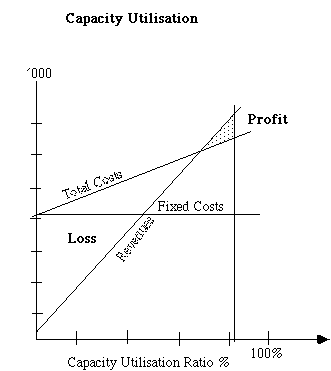
The Knowledge Organisation
by
Karl-Erik Sveiby
Unauthorised copying prohibited.
INDEX.
- The Knowledge Organisation.
- The Market Value.
- The Personnel.
- Corporate Knowhow.
- Corporate Image.
- Investing in Intangible Assets.
- Attract the Customer.
- Attract the Personnel.
- Develop the Competence of the Personnel.
- Utilising Capacity.
- Matching Capacity and Demand.
11.1. The Vicious Circle.
- Managing the Strategic Dilemma.
- Customer Strategies.
- Personnel Strategies.
- Pricing.
- Some Critical Incidents.
- Management Information.
10. Utilising Capacity.
Just like other non-manufacturing or service operations, problem solving can not be stored and then sold later. An unsold hour never returns. This is of vital importance for steering short term profitability, because utilisation of capacity becomes one of the most critical issues in both how to cut costs and how to increase revenues. Once our personnel is onboard it is therefore the capacity utilisation that decides our short-term profitability. There are two ways to increase capacity utilisation:
- By adapting our capacity to the demand (by subcontracting in extra personnel when demand is highest or subcontracting out own personnel when demand is lowest).
- By adapting the demand to our capacity (adding less profitable projects or projects with higher risk).
Using a part of the capacity for internal R&D projects or training is also a method of keeping high capacity utilisation but it means a transfer of liquid funds into less liquid, since we do not receive payment for investment until later.
 Key people are individuals with individual personalities. When organised in teams the key people prefer to work with some and dislike the company of others. Their chemistry function more or less well together. This may make the team more or less flexible and creative in finding solutions when unexpected clogs appear in the projects. The capacity of a team may therefore vary considerably depending on who the members are.
Key people are individuals with individual personalities. When organised in teams the key people prefer to work with some and dislike the company of others. Their chemistry function more or less well together. This may make the team more or less flexible and creative in finding solutions when unexpected clogs appear in the projects. The capacity of a team may therefore vary considerably depending on who the members are.
There are two parties in a problem solving process which affect the outcome - the Customer is also an individual with his or her chemistry. To combine the right team for the right customer is therefore an art in its real sense.
Next Chapter.
Previous Chapter.
Return to Knowledge Management Home Page.


